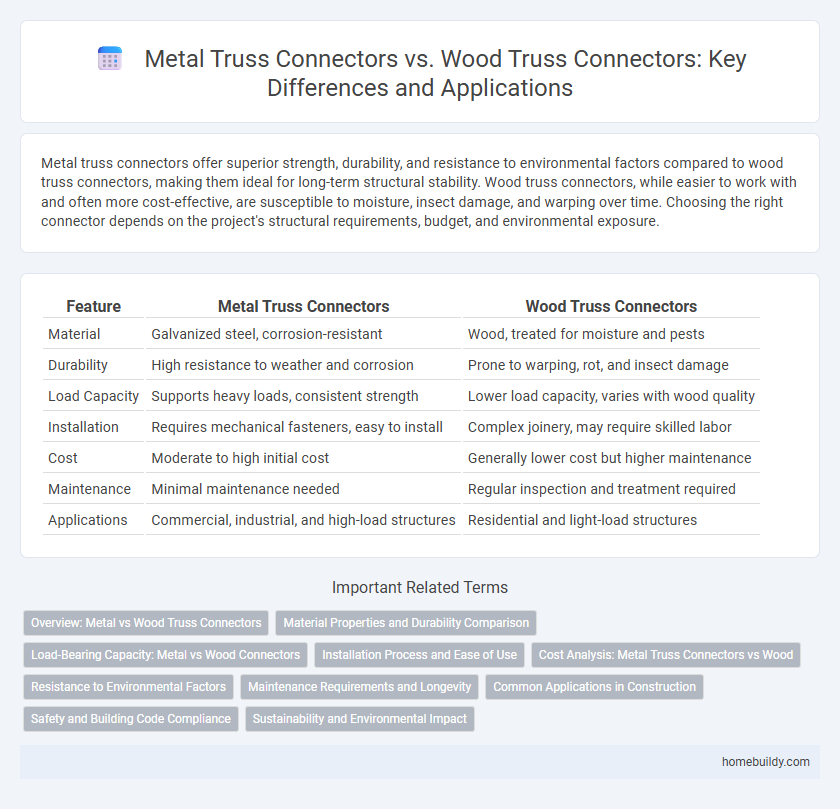Metal truss connectors offer superior strength, durability, and resistance to environmental factors compared to wood truss connectors, making them ideal for long-term structural stability. Wood truss connectors, while easier to work with and often more cost-effective, are susceptible to moisture, insect damage, and warping over time. Choosing the right connector depends on the project's structural requirements, budget, and environmental exposure.
Table of Comparison
| Feature | Metal Truss Connectors | Wood Truss Connectors |
|---|---|---|
| Material | Galvanized steel, corrosion-resistant | Wood, treated for moisture and pests |
| Durability | High resistance to weather and corrosion | Prone to warping, rot, and insect damage |
| Load Capacity | Supports heavy loads, consistent strength | Lower load capacity, varies with wood quality |
| Installation | Requires mechanical fasteners, easy to install | Complex joinery, may require skilled labor |
| Cost | Moderate to high initial cost | Generally lower cost but higher maintenance |
| Maintenance | Minimal maintenance needed | Regular inspection and treatment required |
| Applications | Commercial, industrial, and high-load structures | Residential and light-load structures |
Overview: Metal vs Wood Truss Connectors
Metal truss connectors offer superior strength, corrosion resistance, and consistent performance compared to wood truss connectors, which can be prone to warping, splitting, and pest damage. Metal connectors are typically made from galvanized steel or stainless steel, ensuring long-lasting durability and minimal maintenance in various environmental conditions. Wood truss connectors often rely on nails or wooden pegs, providing less reliable joint stability and shorter lifespan in structural applications.
Material Properties and Durability Comparison
Metal truss connectors, typically made from galvanized steel or stainless steel, offer superior strength and corrosion resistance compared to wood truss connectors, which are often crafted from hardwood or treated softwood. The high tensile and shear strength of metal connectors ensures enhanced load-bearing capacity and long-term durability, particularly in environments prone to moisture or insect damage. While wood connectors provide a more natural and aesthetic integration with timber structures, their susceptibility to warping, splitting, and decay limits their lifespan compared to the resilient, low-maintenance properties of metal alternatives.
Load-Bearing Capacity: Metal vs Wood Connectors
Metal truss connectors exhibit superior load-bearing capacity compared to wood connectors due to their high tensile strength and resistance to deformation under heavy loads. Steel, commonly used in metal connectors, offers enhanced durability and consistent performance in structural applications, ensuring stability in complex truss systems. Wood connectors, while more flexible, tend to have lower load thresholds and are more susceptible to environmental factors like moisture, which can compromise their strength over time.
Installation Process and Ease of Use
Metal truss connectors offer a streamlined installation process with pre-punched holes that align precisely, reducing the need for complex measurements and tools compared to wood truss connectors. Wood truss connectors often require additional fastening steps such as nails or screws, increasing labor time and skill level required. The durability and consistent sizing of metal connectors contribute to greater ease of use and faster assembly in construction projects.
Cost Analysis: Metal Truss Connectors vs Wood
Metal truss connectors typically incur higher initial costs than wood truss connectors due to the price of steel and manufacturing processes, but they offer greater durability and lower maintenance expenses over time. Wood truss connectors are generally less expensive upfront, making them appealing for budget-sensitive projects, but may require more frequent repairs or replacements due to susceptibility to environmental damage. Evaluating long-term cost efficiency, metal connectors can provide better value by reducing lifecycle expenses despite higher installation costs.
Resistance to Environmental Factors
Metal truss connectors demonstrate superior resistance to environmental factors such as moisture, rot, and insect damage, unlike wood truss connectors which are more susceptible to these conditions. Galvanized or stainless steel metal connectors provide enhanced durability and corrosion resistance, extending the lifespan of the truss system. This makes metal connectors particularly advantageous in humid, coastal, or other harsh environments where wood connectors may degrade over time.
Maintenance Requirements and Longevity
Metal truss connectors exhibit superior durability and minimal maintenance requirements compared to wood truss connectors, which are prone to rot, insect damage, and warping over time. The corrosion-resistant properties of galvanized or stainless steel metal connectors enhance longevity, reducing the need for frequent inspections and replacements. Wood truss connectors, though initially less expensive, demand regular treatment and maintenance to prevent decay and structural weakening, ultimately affecting the lifespan of the truss system.
Common Applications in Construction
Metal truss connectors are widely used in commercial and industrial construction for steel roof framing and heavy-duty structural support due to their high strength and durability. Wood truss connectors, commonly employed in residential buildings and light commercial projects, provide efficient joining solutions for timber roof and floor trusses. Both types play crucial roles in ensuring structural integrity, with metal connectors favored in environments requiring corrosion resistance and wood connectors preferred for cost-effectiveness and ease of installation.
Safety and Building Code Compliance
Metal truss connectors offer superior strength and fire resistance compared to wood truss connectors, enhancing overall structural safety in construction projects. These connectors meet stringent building code requirements by providing consistent quality, corrosion resistance, and load-bearing capacity crucial for secure roof and floor assemblies. Compliance with international building standards like ICC and IBC is more easily achieved using metal connectors, reducing risks associated with wood degradation and fastening failures.
Sustainability and Environmental Impact
Metal truss connectors offer enhanced durability and recyclability compared to wood truss connectors, contributing to reduced environmental waste and longer structural lifespans. Wood connectors, while biodegradable, often require chemical treatments that may introduce toxins into the environment, impacting sustainability negatively. The production of metal connectors, primarily using recyclable steel, supports a circular economy and reduces the demand for deforestation associated with wood materials.
Metal truss connectors vs wood truss connectors Infographic

 homebuildy.com
homebuildy.com